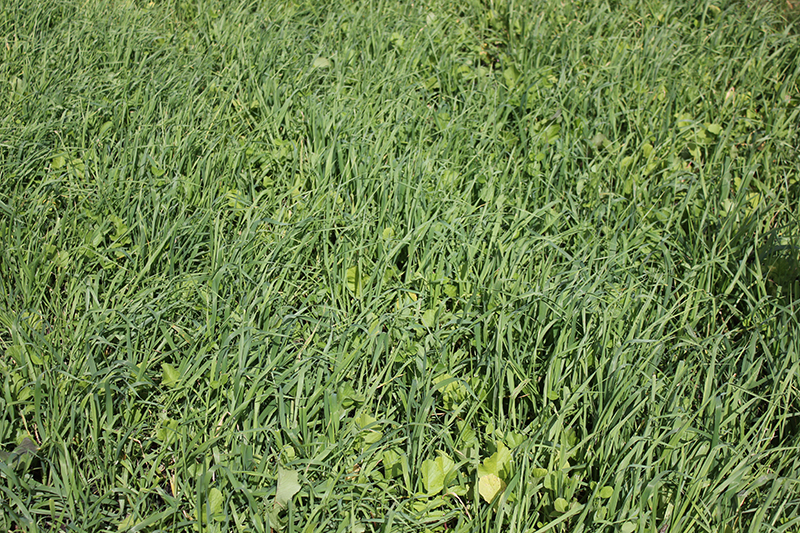By Margaret Smith, PhD
Forage Agronomist
Should you apply nitrogen fertilizer when seeding a new pasture? Does it matter if you are seeding only grasses or a grass/legume mix?
Establishing a new pasture from former cropland or hay ground is the perfect time to soil test and apply lime, P and K, but save some dollars on nitrogen. Perennial grass and legume seedlings are somewhat slow to establish and don’t have enough root system to take up much N in the first six to eight weeks of growth. It’s likely that a significant portion of fertilizer N (beyond 10-30 lbs/A) applied prior to pasture seeding will leach below the root zone of forage plants before their roots have reached eight inches deep.
We agree with recommendations from the University of Nebraska, to apply no nitrogen when establishing grass pastures. This recommendation extends to grass-legumes pastures, too. Nitrogen fertilizer for pasture grass applied to new legume seedings may give them a slight ‘boost’ but will also delay development of their nitrogen-fixing capabilities.
With either type of new seeding, the major impact of early nitrogen fertilization will be to feed annual weeds, making them even more competitive with the perennials species you’re working to establish. Plant a small grain companion crop with your perennials to help compete with fast-growing annual weeds. A small amount of nitrogen (30-40 lb/A) may improve the forage yield of the small grain, depending on nitrogen credits from soybeans. Keep this rate moderate to avoid feeding annual weeds. Oat, barley or triticale forage can be either grazed or hayed off at the boot stage of growth.
If soil moisture is good and rainfall predicted in mid-summer, new grass pastures can be top dressed with N (about 40 lbs/A) later in the season (about mid-July in Southern Minnesota). NiNitrogen recommendations for established grass pastures, including when you fertilize new grass, are usually for split applications. Similar to a corn crop, you’re trying to match fertilizer application timing with crop use. Cool season perennial grasses produce the most growth in the spring, slow their growth during the warmer summer months and produce a second flush of growth in the fall. New seedings should be established and primed to take advantage of fertilizer N in the late summer and early fall.
Grass-only pastures will benefit from nitrogen additions each year (consider split N applications). BUT, both the fertilizer and the labor for application are repeated costs.
Grow Your Own! Legumes in Pasture: The Alternative to Nitrogen Fertilizer
Managers know that, “a cost, once eliminated, never goes up.” Eliminate repeated yearly costs for N fertilizer on pasture by seeding a legume with your grasses. In western Minnesota at UM Morris, dry matter yields from mixed legume and grass forage seedings were greater than pure grass stands with 200 lbs/A of N fertilizer applied. Legumes in a pasture mix also improve palatability and digestibility of the sward.
Management Consideration for Legumes in Your Pasture Stand
- Keep legumes in your pastures by managing your grazing and allowing adequate recovery periods for both legumes and grasses before returning livestock to any paddock. Recovery periods will range from about 30 to 45 days through the growing season in in the Upper Midwest (and longer during drought periods).
- With much shorter recovery periods or with set stocking and long-term duration grazing you can maintain white Dutch clover and birdsfoot trefoil (once well established) in the stand, but will graze out other white clovers, red clovers, and alfalfa.
- Depending on your class of livestock to be grazed and planned grazing management, you can manage 30 percent to 50 percent legume in the stand and easily manage the potential for bloat. Some farmers do graze higher percentages of legume in pasture stands, up to 100 percent alfalfa, for example, but this increases the chance for bloat. This is not for the faint of heart.
- More frequent moves between paddocks insure a more consistent forage mass in the rumen, for instance, which lowers the potential for bloat.
- Grazing more mature legumes that have started flowering also reduces bloat risk.
- pH and sulfur needs are more important for legumes than for grasses, so take them into consideration. The suggested pH is 6.8- 6.9 for most legumes (actually for the associated rhizobium that fix nitrogen for the legumes). We definitely recommend soil testing before seeding, though time is now short for this spring.
RESOURCES
- Steps to Establishing Grass-Legume Pastures (Iowa State University Extension)
- Pasture Management Guide for Livestock Producers (Iowa State University Extension)
- Dairy Grazing: Pasture Establishment (Missouri State Extension)
- Converting Cropland to Grass Pastures (University of Nebraska-Lincoln Extension)
- Establishing Dryland Forage Grasses (University of Nebraska-Lincoln Extension)
- Nitrogen Management for Grass Pastures (University of Wisconsin-Madison)
